|
||||||
|
CALAMAGROSTIS. Small-reeds. [Poaceae] |
|
Six species of Calamagrostis are recorded in Britain. These include Purple Small-reed (C. canescens), Wood Small-reed or Purple marram (C. epigejos), Scandinavian Small-reed (C. purpurea), Scottish Small-reed (C. scotica) and Narrow Small-reed (C. stricta). The BSBI provide a downloadable plant crib for Calamagrostis. Narrow Small-reed (C. stricta) is protected in Northern Ireland under Schedule 8 of the Wildlife (Northern Ireland) Order, 1985. Twenty-five British miners are recorded on Calamagrostis. The gelchiid Helcystogramma rufescens spins grass blades and feeds inside the spiral spinning, causing whitening of the grass blade tip. Nearly 100 British miners or possible miners are recorded on grasses in Britain. A key to the European miners recorded on Calamagrostis is provided in Bladmineerders van Europa. It is recommended that adults of all miners on grasses be reared to be certain of their identity. |
Key for the identification of the known mines of British |
Note: Diptera larvae may live in a corridor mine, a corridor-blotch mine, or a blotch mine, but never in a case, a rolled or folded leaf, a tentiform mine or sandwiched between two more or less circular leaf sections in later instars. Pupation never in a cocoon. All mining Diptera larvae are leg-less maggots without a head capsule (see examples). They never have thoracic or abdominal legs. They do not have chewing mouthparts, although they do have a characteristic cephalo-pharyngeal skeleton (see examples), usually visible internally through the body wall. The larvae lie on their sides within the mine and use their pick-like mouthparts to feed on plant tissue. In some corridor miners frass may lie in two rows on alternate sides of the mine. In order to vacate the mine the fully grown larva cuts an exit slit, which is usually semi-circular (see Liriomyza huidobrensis video). The pupa is formed within the hardened last larval skin or puparium and as a result sheaths enclosing head appendages, wings and legs are not visible externally (see examples). See Key to non-Diptera. |
1# > Leaf-miner: Details unknown. Pupation internal (Spencer, 1972b: 104, as deschampsiae). |
|
Cerodontha imbuta (Meigen, 1938) [Diptera: Agromyzidae]. |
1a > Leaf-miner: Normally several larvae feed together. Pupation in the mine. Puparium shining black (Spencer, 1976: 198). Broad elongated blotch. Frass greenish. Larvae generally communal. Pupation within the mine. The black puaria are individially anchored within the mine with a silken thread attached at their rear end. Distinguishable from C. incisa only by means of the larva. |
|
Cerodontha pygmaea (Meigen, 1830) [Diptera: Agromyzidae]. |
1b > Leaf-miner: Broad elongated mine; the form is dependent of the leaf form of the host plant. Frass green. Usually a number of larvae together in a mine. Pupation in the mine. |
|
Cerodontha incisa (Meigen, 1830) [Diptera: Agromyzidae]. |
1c > Leaf-miner: Lower-surface corridor in the top half the leaf blade; the mine changes direction at least two times. One to three larvae in a mine. Frass in rather regular granules. |
|
Cerodontha atra (Meigen, 1830) [Diptera: Agromyzidae]. |
1d > Leaf-miner: Broad lower surface mine which generally starts at the leaf apex.The mine is somewhat irregular in depth. Frass in irregular black-green, frequently melted grains, mostly along the edges of the mine. Larva solitary. Pupation generally internal. |
|
Cerodontha muscina (Meigen, 1830) [Diptera: Agromyzidae]. |
1e > Leaf-miner: Larva feeds mainly in the leaf sheaths. The short mines which may be formed in the leaf blade may be easily overlooked. Pupation internal (Spencer, 1976: 178). Mine begins as a narrow, usually upper-surface, occasionally lower-surface or interparenchymatous corridor in the blade, that descends towards the ligule, thence continues into the leaf sheath, generally on its inside. Usually only one mine per leaf. Puparium in a puparial chamber at the margin of the leaf sheath. Neither mine nor larva can be distinguished from that of C. fulvipes that, as far as is known, only feeds on Poa trivialis. |
|
Cerodontha denticornis (Panzer, 1806) [Diptera: Agromyzidae]. |
| 1f > Leaf-miner: Lower-surface corridor; larva solitary. Pupation mostly outside the mine. |
|
Cerodontha calamagrostidis Nowakowski, 1967 [Diptera: Agromyzidae]. |
1g > Leaf-miner: A lower surface mine. Pupation normally in the ground (Spencer, 1976: 202). Broad, usually lower-surface corridor in the blade, generally first rising, then descending. Mostly one larva in a mine, but sometimes several mines on a leaf may merge. Frass in grains that gradually become both larger and more widely spaced. Pupation outside the mine. |
|
Cerodontha flavocingulata (Strobl, 1909) [Diptera: Agromyzidae]. |
| 1h > Leaf-miner: A
long irregular mine in late summer and autumn, overwintering low
in the stem, burrowing into a young leaf and continuing feeding
the following spring (Spencer,
1976: 177).
At least part of the mine consists of a very long, narrow, full depth corridor that is almost free of frass. The larva moves from one leaf to the other by way of the leaf sheath; most frass to be found in the leaf sheaths. |
|
Cerodontha hennigi Nowakowski, 1848 [Diptera: Agromyzidae]. |
1i > Leaf-miner: Larval leaf-mine starts as a narrow channel running towards apex of leaf but later develops into a broad blotch running downwards. Frass largely diffused, giving the mine a characteristic greenish appearance. Pupation external (Spencer, 1976: 126). Corridor, usually several in one leaf, running from close to the leaf base up to near the tip, then reversing direction and widening, resulting in one communal mine in which the larvae descend in a common front. Frass somewhat deliquescent, mine therefore strikingly green. Pupation outside the mine. Neither mine nor larva distinguishable from those of mobilis. Puparium reddish brown |
|
Agromyza nigrella (Rondani, 1875) [Diptera: Agromyzidae]. |
1j > Leaf-miner: Mine greenish with only single larva, initially running towards apex of leaf before turning back down and developing into a broad blotch (Spencer, 1972b: 32, fig. 84; Spencer, 1976: 140, fig. 251). Deep, transparant corridor-blotch. The mine begins not far from the leaf apex, at first running upwards as a narrow corridor, then reverses and quickly widens to a blotch. A single larva per mine. Frass in isolated grains. Pupation inside or outside the mine. The mine is illustrated in the Encyclopedia of Life. Puparium reddish brown |
|
Agromyza rondensis Strobl, 1900 [Diptera: Agromyzidae]. |
1k > Leaf-miner: Long, narrow, whitish mine. Pupation internal (Spencer, 1976: 453); anterior spiracles projecting through the epidermis. Whitish, upper-surface, rather narrow corridor with comparatively large frass grains that are laying further apart than their diameter. Pupation within the mine. The anterior spiracles of the orange-brown puparium penetrate the epidermis. |
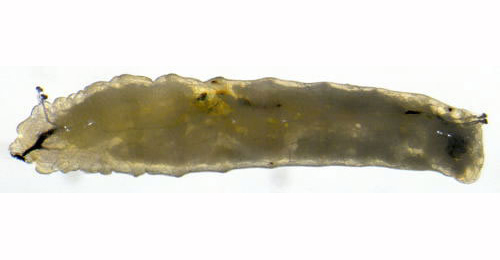 Chromatomyia nigra larva, lateral Image: © Willem Ellis (Bladmineerders van Europa) |
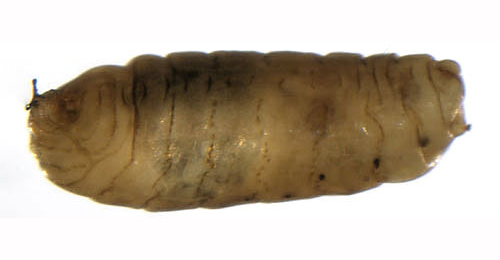 Chromatomyia nigra pupa, lateral Image: © Willem Ellis (Bladmineerders van Europa) |
|
Chromatomyia nigra (Meigen, 1830) [Diptera: Agromyzidae]. |
1l > Leaf-miner: Long upper-surface corridor usually containing several larvae that graze shoulder to shoulder from the leaf tip downwards. Pupation outside the mine. Mines and larvae are indistinguishable from those of A. nigrella. |
|
Agromyza mobilis Meigen, 1830 [Diptera: Agromyzidae]. |
1m > Leaf-miner: A narrow whitish linear mine, running down the leaf from the apex, with frass in two rows of separate grains. Pupation external (Spencer, 1976: 246). Narrow corridor from start to end, whitish, uppper- or lower-surface, genarally running downwards. Mine often along the leaf margin. Frass in distict grains of regular size, alternating along the sides of the corridor. Pupation outside the mine. |
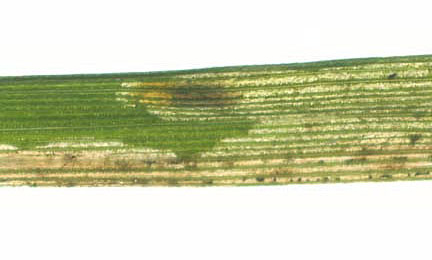 Mine of Liriomyza flaveola on Festuca gigantea Image: © Willis Ellis (Bladmineerders van Europa) |
|
Liriomyza flaveola (Fallén, 1823) [Diptera: Agromyzidae]. |
1n > Leaf-miner: Irregular mine, locally shallow, elsewhere much deeper, giving it a mottled appearance. In broadleaved plants the mine often begins as a blotch with stellate extensions, but sometimes as a very fine, shallow corridor. In grasses the mine often begins in the leaf sheath. The frass is very fine-grained, initially scattered, later in aggregates. The egg is deposited on the plant surface, and the empty egg shell remains visible. But the larvae are able to leave their mine and restart elsewhere, thus mines without an egg shell can be found as well. The larva also leaves the mine before pupation. Pupation takes place in a newly made, small, blotch mine without frass; this mine may be made in another plant (species). |
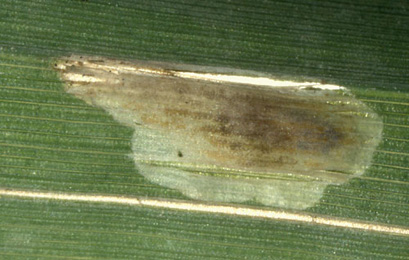 Mine of Hydrellia griseola on Glyceria fluitans Image: © Willem Ellis (Bladmineerders van Europa) |
|
Hydrellia griseola (Fallén, 1813) [Diptera: Ephydridae]. |
|
Key for the identification of the known mines of British |
|
Note: The larvae of mining Coleoptera, Hymenoptera and Lepidoptera may live in a corridor mine, a corridor-blotch mine, a blotch mine, a case, a rolled or folded leaf, a tentiform mine or sandwiched between two more or less circular leaf sections in later instars. Larva may pupate in a silk cocoon. The larva may have six legs (although they may be reduced or absent), a head capsule and chewing mouthparts with opposable mandibles (see video of a gracillarid larva feeding). Larvae of Hymenoptera and Lepidoptera usually also have abdominal legs (see examples). Frass, if present, never in two rows. Unless feeding externally from within a case the larva usually vacates the mine by chewing an exit hole. Pupa with visible head appendages, wings and legs which lie in sheaths (see examples). |
|
1a > Leaf-miner: Tufted hair-grass and blue moor-grass are the main foodplants, the larvae forming gallery mines. Gradually widening corridor, running either upwards or down. All frass is deposited in the earliest part of the mine. Often 2-3 larvae in a mine; in grasses with broad leaves sometimes more than one mine in a leaf. |
|
|
|
Elachista adscitella Stainton, 1851 [Lepidoptera: Elachistidae]. |
|
1b > Leaf-miner: Corridor, 15 cm in the end, descending from the leaf tip. The mine is whtish and shallow at first, then becomes deeper, yellowish white, and more transparant. Pupation external; pupa, not in a cocoon, attached to the leaf. |
|
|
|
Elachista albidella Nylander, 1848 [Lepidoptera: Elachistidae]. |
|
1c > Leaf-miner: The larva mines from the grass tip downwards and the mine occupies half or the whole of the leaf blade width. A whitish blotch is formed with characteristic narrow streaks of frass. Full depth blotch, slightly inflated, descending from the leaf tip, occupying half or the entire width of the blade. The larva may move and make a new mine elsewhere. In the latter case the mines are fairly short; otherwise an entire blade may be mined out. Frass in a some narrow greyish brown streaks. Pupation outside the mine. |
|
|
|
Elachista albifrontella (Hübner, 1817) [Lepidoptera: Elachistidae]. |
|
1d > Leaf-miner: Corridor widening while descending from the tip of the leaf. The mine is unusual because the sides are very irregularly scalloped out. Moreover, the mine is not evenly transparent, but rather yellowish green and motly, because the larva leaves patches of parenchyma uneaten, and does not feed full depth. Frass in a few irregular, interrupted length lines. Often 2-3 larvae in a mine. The larvae hibernate in the centre of the mine; after winter they leave their mine and pupate. |
|
|
|
Elachista apicipunctella Stainton, 1849 [Lepidoptera: Elachistidae]. |
|
1e > Leaf-miner: In autumn the larva makes a narrow corridor a few cm in length, in which it hibernates. In March it moves to a new leaf. Here a transparent, full depth mine is made that descends from the leaf tip, and occupies the entire width of the blade. Most frass is concentrated in the oldest, highest, part of the mine. The larva may leave its mine and restart elsewhere. Pupation outside the mine |
|
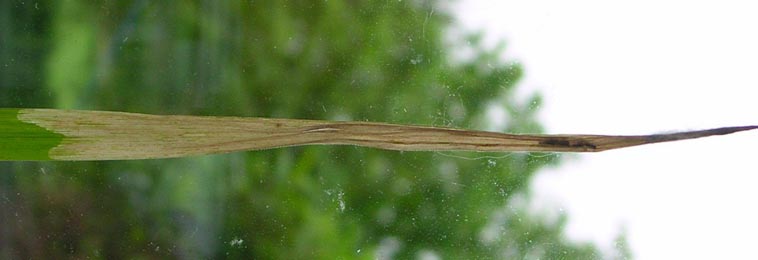 Mine of Elachista argentella on Dactylis glomerata Image: © Ben Smart (British leafminers) |
|
|
|
Elachista argentella (Clerck, 1759) [Lepidoptera: Elachistidae]. |
|
1f > Leaf-miner: Mine a descending and widening corridor, in the end an elongate blotch that may occupy the entire width of the leaf. The mine contracts somehat, narrowing the leaf. Frass in some elongate lumps in the centre of the mine. |
|
|
|
Elachista bisulcella (Duponchel, 1843) [Lepidoptera: Elachistidae]. |
|
1g > Leaf-miner: Larva makes a large whitish blotch and mines the leaf downwards. The frass tends to be deposited in the upper part of the mine. Oviposition usually not far from the leaf tip. From there descends an irregular blotch mine. Hering (1957a) describes the mine as flat and quite shallow, giving it a greenish, rather than whitish appearance. Frass initially in the oldest, upper part of the mine, later in strings. The larva can leave its mine and restart elsewhere. Normally only one larva per mine, but sometimes two or even three mines in a leaf. Pupation outside the mine. |
|
|
|
Elachista maculicerusella (Bruand, 1859) [Lepidoptera: Elachistidae]. |
|
1f > Leaf-miner: Initially a narrow brownish mine with blackish frass at its base, then moves to another leaf, forming a broader mine. Both mines can pucker the blade. |
|
|
|
Elachista obliquella Stainton, 1858 [Lepidoptera: Elachistidae]. |
|
1g > Leaf-miner: The mine begins near the leaf tip and descends towards the base. The mine occupies the entire width of the blade. Frass initially scattered, later in an irregular central line. Fully developed mine c. 8 cm long. Probably the larva is capable of leaving its mine and restarting in another leaf. Pupation external. |
|
|
|
Elachista pomerana Frey, 1870 [Lepidoptera: Elachistidae]. |
|
1h > Leaf-miner: Mines downwards from leaf tip to stem. Makes a long narrow yellowish mine. May be up to four larvae in one leaf. Long narrow yellowish corridor, descending from the leaf tip to its base; at times 3-4 larvae in a leaf. Often several larvae in a communal mine. Pupation outside the mine. |
|
|
|
Elachista stabilella Stainton, 1858 [Lepidoptera: Elachistidae]. |
|
1i > Leaf-miner: The larva creates a long narrow mine in the blade. Mine fairly translucent. It starts as a narrow corridor, running towards the leaf tip, but this almost invariably is overrun be a later, broad, descending corridor. The centre of the mine contains a vertical tube made of loose silk, in which the larva can quickly move up or down, and in which also most frass gets trapped. The sides of the mine are smooth (contrary to E. gangabella). Mines are difficult to find, because the leaves are wilting when larvae are present. |
|
|
|
Elachista subalbidella Schläger, 1847 [Lepidoptera: Elachistidae]. |
|
1j > Leaf-miner: Narrow, flat, corridor descending from the leaf tip. Frass in an almost continuous line. The larva usually makes several mines. Mines pale yellow green at first, turning purple later. Pupation external. |
|
|
|
Elachista subnigrella Douglas, 1853 [Lepidoptera: Elachistidae]. |
| Last updated 01-Jul-2019 Brian Pitkin | ||
